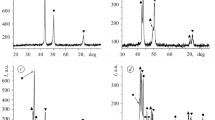Abstract
Thermodynamic properties of liquid alloys in the Cd−Bi system have been investigated by theemf method from 9 to 90 at % Cd between 380 and 520°C. The activities of Cd of Cd-poor and Cd-rich alloys show a weak positive, in between a negative deviation from ideal behaviour. The partial molar enthalpy is positive and decreases monotonically with increasing Cd content with the exception of the range between 50 and 75 at % Cd where it exhibits an anomalous behavior. The integral enthalpy of mixing is positive, with a maximum value of +200 cal/g-atom at 50 at % Cd at 500°C. The enthalpy curve, which is otherwise parabolic, has a flat portion between 50 and 80 at % Cd. The molar heat capacities show a small negative deviation from theNeumann—Kopp rule. The partial and integral entropies are shifted towards positive values as compared to the ideal entropies. The partial entropy shows also an anomalous concentration dependence between 50 and 65 at % Cd. The data are generally in good agreement with the reliable results reported in literature. The only deviations occur in the anomalous region. The anomalous behavior of the Cd−Bi melts between 50 and 70 at % Cd is probably due to a weak short range order, but a tendency towards unmixing cannot be excluded with certainty as the cause of the anomaly.
Zusammenfassung
Thermodynamische Eigenschaften von flüssigen Legierungen im System Cd−Bi wurden im Bereich von 9 bis 90 At % Cd zwischen 380 und 520°C mittels derEMK-Methode bestimmt. Die Aktivitäten von Cd zeigen für Cd-arme und Cd-reiche Legierungen eine schwach positive, dazwischen eine negative Abweichung vom idealen Verhalten. Die partielle molare Enthalpie ist positiv und fällt mit zunehmendem Cd-Gehalt monoton ab. Zwischen 50 und 75 At % Cd zeigt Δ−H Cd jedoch ein anomales Verhalten. Die integrale Mischungsenthalpie ist positiv, mit einem Maximalwert von +200 cal/Grammatom bei 50 At % Cd und 500°C. Zwischen 50 und 75 At % Cd ist die sonst parabolische Enthalpiekurve abgeplattet. Die Molwärmen zeigen ein schwach negatives Abweichen von derNeumann—Kopp-Regel. Die partiellen und integralen Entropien sind gegenüber den idealen Größen zu positiven Werten verschoben. Die partielle Entropie zeigt zwischen 50 und 65 At% Cd ebenfalls eine anomale Konzentrationsabhängigkeit. Die gefundenen Werte stimmen im allgemeinen gut mit den verläßlichen Literaturdaten überein. Nur im anomalen Gebiet ergeben sich Abweichungen. Das anomale Verhalten der Cd−Bi-Schmelzen zwischen 50 und 70 At% Cd ist wahrscheinlich auf eine schwache Nahordnung zurückzuführen, doch ist eine Entmischungstendenz als Ursache nicht mit Sicherheit auszuschließen.
Similar content being viewed by others
Literatur
M. Hansen, Constitution of Binary Alloys, S. 303. New York: McGraw-Hill (1958).
R. P. Elliott, Constitution of Binary Alloys, First Supplement, S. 177. New York: McGraw-Hill. 1965.
F. A. Shunk, Constitution of Binary Alloys, Second Supplement, S. 124. New York: McGraw-Hill. 1969.
N. W. Taylor, J. Amer. Chem. Soc.45, 2865 (1923).
J. F. Elliott undJ. Chipman, Trans. Faraday Soc.47, 138 (1951).
S. Mellgren, J. Amer. Chem. Soc.74, 5037 (1952).
A. V. Nikol'skaya undYa. I. Gerasimov, J. Fiz. Khim.28, 713 (1954).
Ya. I. Gerasimov, A. V. Nikol'skaja undA. M. Evseev, J. Chim. Physique56, 641 (1959).
J. Vřeštál, Czech. J. Phys.B, 13, 286 (1963).
Y. Chiba, T. Matsushima undK. Ono, Tohoku Daigaku Senko Serien Kenkyusho Iho21, 15 (1965).
L. F. Kozin, R. Sch. Nigmetova undA. M. Dairova, J. Fiz. Khim.42, 698 (1968).
E. Wachtel undS. Nazareth, Z. Metallkde.56, 20 (1965).
F. Wüst undR. Durrer, Forsch. Gebiete Ingenieurw.204 (1918).
F. Wüst undR. Durrer, Forsch. Gebiete Ingenieurw.241 (1922).
M. Kawakami, Sci. Repts. Tohoku Univ.16, 915 (1927).
Ya. I. Geguzin undB. Ya. Pines, Dokl. Akad. Nauk SSSR75, 535 (1950).
S. Nagasaki undE. Fujita, Nippon Kinzoku Gakkai-Si (Japan Inst. Metals)16, 313 (1952).
W. Oelsen, W. Tebbe undO. Oelsen. Arch. Eisenhüttenw.27, 689 (1956).
W. Oelsen, K. Bierett undG. Schwabe, Arch. Eisenhüttenw.27, 607 (1956).
F. E. Wittig, E. Müller undW. Schilling, Z. Elektrochem. Ber. Bunsenges. phys. Chem.62, 529 (1958).
B. Dobovisek undB. Straus, Rudarsko-Met. Zbornik3, 273 (1960).
O. Kubaschewski undJ. A. Catterall, Thermochemical Data of Alloys, S. 115. London: Pergamon Press. 1956.
R. Hultgren, R. L. Orr, P. D. Anderson undK. K. Kelley, Selected Values of Thermodynamic Properties of Metals and Alloys. New York: Wiley. 1963.
Ya. Dumschak, V. Ya. Prokhorenko undN. M. Klym, Sov. Phys. Solid State7, 1596 (1966).
R. Geffken, K. L. Komarek undE. Miller, Trans. TMS-AIME239, 1151 (1967).
E. Hayer undK. L. Komarek, Veröffentlichung in Vorbereitung.
Komplexometrische Bestimmungsmethoden mit Titriplex, E. Merck AG., Darmstadt.
K. L. Komarek undG. Stummerer, Mh. Chem.102, 1360 (1971).
A. Ölander, Z. physik. Chem.165 A, 65 (1933).
M. Ettenberg, K. L. Komarek undE. Miller, Ordered Alloys: Structural Application and Physical Metallurgy (B. H. Kear et al., Hrsg.). Baton Rouge: Claitor's Publ. Div. 1970.
K. L. Komarek undK. Wessely, Mh. Chem.103, 896 (1971).
E. Scheil undE. D. Müller, Z. Metallkde,53, 389 (1962).
O. J. Kleppa, Acta Met.6, 233 (1958).
Author information
Authors and Affiliations
Additional information
Mit 6 Abbildung
Rights and permissions
About this article
Cite this article
Komarek, K.L., Stummerer, G. Thermodynamische Untersuchungen im System Cadmium-Wismut. Monatshefte für Chemie 104, 32–47 (1973). https://doi.org/10.1007/BF00911143
Received:
Issue Date:
DOI: https://doi.org/10.1007/BF00911143



